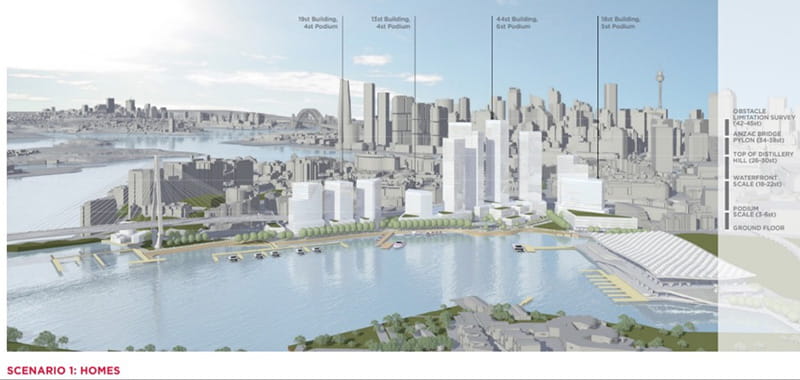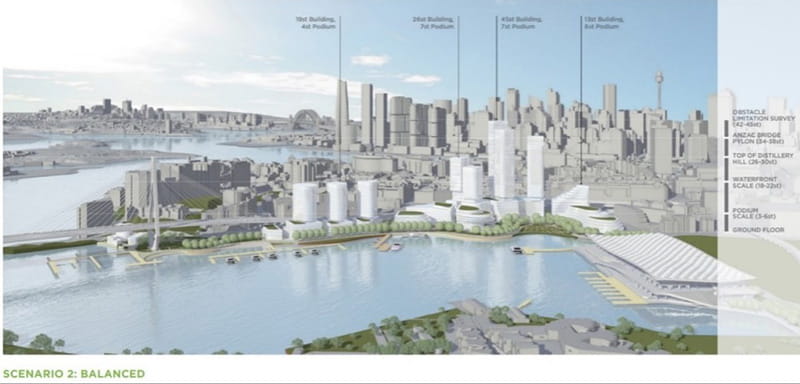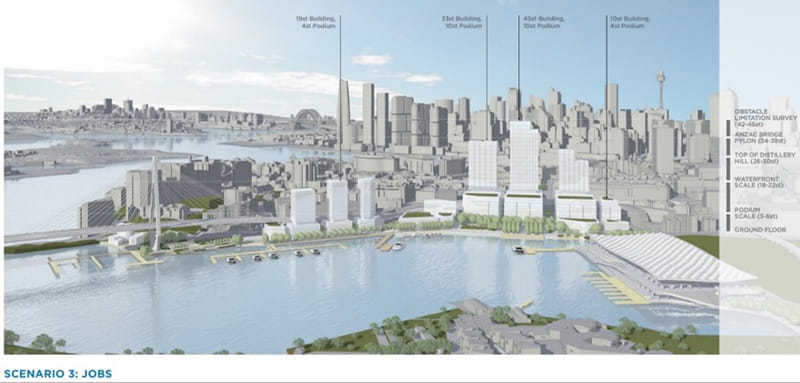Two very significant steps in the redevelopment of the Blackwattle Bay foreshores have been made public in the last two weeks. Firstly, Infrastructure NSW released a glossy brochure, ‘Revitalising Blackwattle Bay’, setting out its ‘Blackwattle Bay Precinct Planning Scenarios’, as the basis for an intensive period of community ‘engagement’ on the redevelopment of the Pyrmont foreshores including the current Sydney Fish Market (SFM) site. Secondly, the NSW government announced on Friday 22 May that the new $749m SFM will be fast tracked as part of its second tranche of accelerated projects to create jobs, boost investment and deliver a public benefit (More planning projects to propel future of NSW).
These are inter-related projects: the foreshore redevelopment cannot commence until the SFM has moved to its new site. Thus, the fast-tracking.
The new Sydney Fish Market
In practical terms, the Government’s inclusion of the new SFM in this list ensures it will go ahead.
We note that the development application for the new SFM building has not yet been approved – but the Minister assures us that a decision will be released in four weeks. Not that there is anything for the Government to worry about – the proponent and the approving body are both part of the one Government agency. And beyond that, the Minister has discretionary power of approval anyway.
The Glebe Society is fully supportive of the need for a new SFM but has argued that the chosen site on the head of the Bay (and over the Bay) has major problems to which no solutions are yet evident. We can only hope that the pending approval will include solutions for the identified parking and traffic congestion problems – and perhaps the community might even get a serious Transport Plan for the area.
The increase in the cost of the new SFM construction from the original $250m to $749m – largely because of the technical problems associated with the difficult on-water site – will clearly detract from the Government’s capacity and willingness to provide for the ‘public good’ in the flow-on redevelopment of the foreshores. That $499 million could provide a goodly stock of much needed affordable and social housing in the residential mix as well as more social infrastructure and open foreshore space.
As we have previously noted, the design, scope and extravagant cost of the new SFM have been significantly shaped by the projections of massive numbers of overseas tourists visiting the site (4-6 million p.a. variously cited). These projections post-COVID are now highly uncertain – especially in relation to Chinese tourism.
Fast tracking infrastructure and job creation spending to support the NSW economy in the COVID-19 shutdown-exit phase is a positive Government initiative – but our concerns about the new site have not diminished.
Blackwattle Bay Precinct Planning Scenarios
Very recent history
The publicly owned 8.4 hectares of land on Blackwattle Bay is the biggest redevelopment site available in the immediate vicinity of the CBD – and it is on the Sydney Harbour Foreshore. This makes it valuable and all but unique. For years, developers have been pushing unsolicited proposals to develop it and the community (in Glebe as well as Pyrmont/Ultimo) has been fighting to protect the site from profit driven over-development and ensure that the public interest has precedence in its future development.
The very recent background to this scenario is worth recalling.
Since the Premier’s furious reaction to the Department of Planning’s recommendation against approval of the 66-storey Star Casino Tower last year, there has been a flurry of Government and agency activity to ‘revitalise’ and ‘update’ (i.e. loosen up) the planning controls and processes for the Pyrmont area.
The immediate outcome was a super-fast review by the Greater Sydney Commission [GSC] which found: the planning framework ‘has failed to deliver on the economic and jobs potential of the area’ and recommended a ‘rejigged planning process which will provide a fast track to ‘revitalising’ development focussed on economic activity and jobs ‘.
The Government accepted the GSC report and this Blackwattle Bay scenario is the first step in that ‘revitalisation’ of the Pyrmont planning controls.
What has been surprising – and somewhat alarming for the residents of Pyrmont – is that the Blackwattle Bay foreshore scenario has been released in advance of the scenario for the rest of the Pyrmont Precinct. It is highly likely that the zoning controls relating to density and height of buildings set for the Blackwattle Bay foreshore will also apply on the other side of the western distributor.
The redevelopment of this site cannot commence until the new SFM is completed in 2024-25. So, there was no hurry on that account.
What is proposed?
Three scenarios for development are proposed. Most significantly they vary in the mix of housing and commercial/employment related development:
- s1: 4,000 jobs 1,700 homes (58%)
- s2: 5,000 jobs 1,160 homes (44%)
- s3: 7,000 jobs 1,045 homes (34%)
Across these three scenarios housing variously encompasses 58%, 44% and 34% of the development.
They also have different mixes of internal ‘movement’ options (walking, cycling, public/private vehicles) and differing design styles and themes. All have 30.000 m2 open space.
The community is invited to give their views on these three options – and people will have a range of views on the relative positives and negatives of each. However, the three scenarios have more in common than in differences – see below for the artists’ impressions taken from the brochure.



The three scenarios are a great deal more similar than they are different – the illusion of choice? (source: Infrastrucre NSW)
The critical parameters are the density of development (c. 250,000 m2 of Gross Floor Area [GFA]) and the height of buildings (3-45 storeys) which apply to all options. All three scenario options will likely generate a similar population density, whether residents or workers. This common GFA requirement appears to be non-negotiable as does the range in height of the buildings.
The Glebe Society is not opposed to high rise development but the proposal for 45-6 storeys has shocked many residents. A 45-storey building has a height of 156m, considerably taller than the pylons of the Anzac Bridge which are 120m. It is way beyond proposals that have been previously considered viable for the site or the area – and breaches the planning regulations for the area.
Some protections are promised: design and placement will ensure that Wentworth Park and the Glebe foreshore are not overshadowed between 9am and 3pm in winter and buildings closer to the heritage listed Anzac Bridge pylon will have lower heights so the Bridge remains a landmark feature in the urban landscape. These are important but very limited protections.
In justifying this radical loosening of the zoning rules Infrastructure NSW offers this explanation:
After careful consideration, and a foundation of evidence-based technical studies and key requirements, we have concluded that Blackwattle Bay could accommodate up to approximately 250,000m2 of Gross Floor Area which would support between 1000 to 1700 homes and 4000 to 7000 jobs. We envisage the site could accommodate a range of building heights from low scale 3 to 45 storeys high. (p.2)
We have formally sought copies of the ‘evidence-based technical studies’ to give us some tangible understanding of the basis for these new density and height parameters which we think are excessive for this site.
Affordable housing: There is a passing refence in the glossy brochure to the possible provision of a small quantum (5-10%) of affordable housing (p.23). If residential development is to be a major element in this redevelopment the Government needs to provide for a much larger proportion of affordable and social housing. The 5-10% formula is old thinking and will not come anywhere near addressing the current, and likely increasing, crisis in access to housing for people on low incomes. This is especially so in the inner-city areas.
A new funding and provision model must be developed by the NSW Government to ensure that all housing developments on publicly owned land deliver a significant proportion of affordable housing – closer to 50% than 5%. It would be shameful if the suggestion made recently by an official that significant affordable housing (i.e. homes for the non-affluent) is not likely to be approved on a harbour foreshore site.
Positive elements: There are significant positive aspects to the scenarios presented. The Blackwattle Bays foreshore walk is a major feature though there are concerns as to the mixed use by pedestrians, cyclists and skaters. The improved linkages to the surrounding area will help cope with easier access to the city and surrounds. The mix of development and the internal travel options – from no vehicles to various mixes – will generate a variety of reactions, but it is good to see the options up for community discussion.
Unanswered issues and next steps
There is still no transport / traffic plan for the area and the problems that will emerge still look insoluble to many of us. There is minimal reference to social infrastructure needs that will be generated by this new residential and working population.
The Glebe Society will be examining this proposal in detail and in discussion with other resident groups as the basis for our formal response to Infrastructure NSW which is due by 5pm on 19 June.
We will be making regular comment on the Glebe Society’s Facebook page.
What you can do
- Read the brochure (access from Infrastructure NSW).
- Walk along the foreshore and consider the proposals.
- Participate in the webinars.
- Make a formal submission to Infrastructure NSW (by 5 pm, 19 June 2020).
- Share your ideas with us.
Lesley Lynch
Bays and Foreshores Convenor










There are no comments yet. Please leave yours.